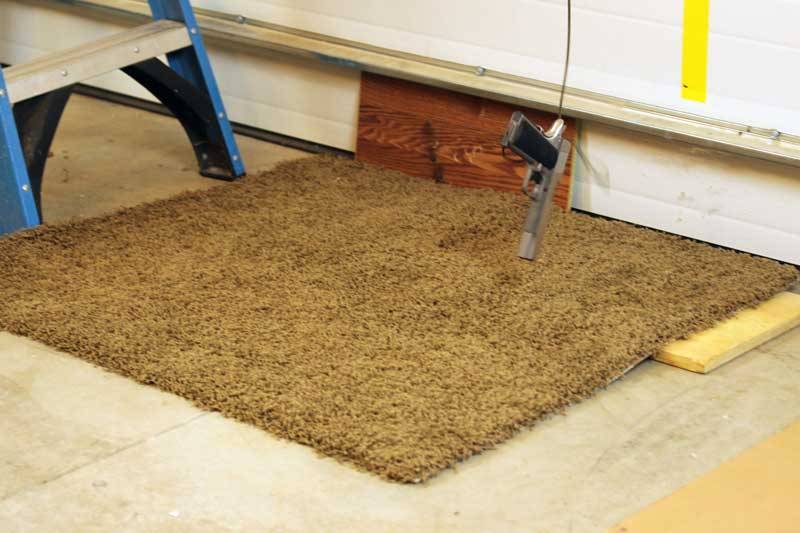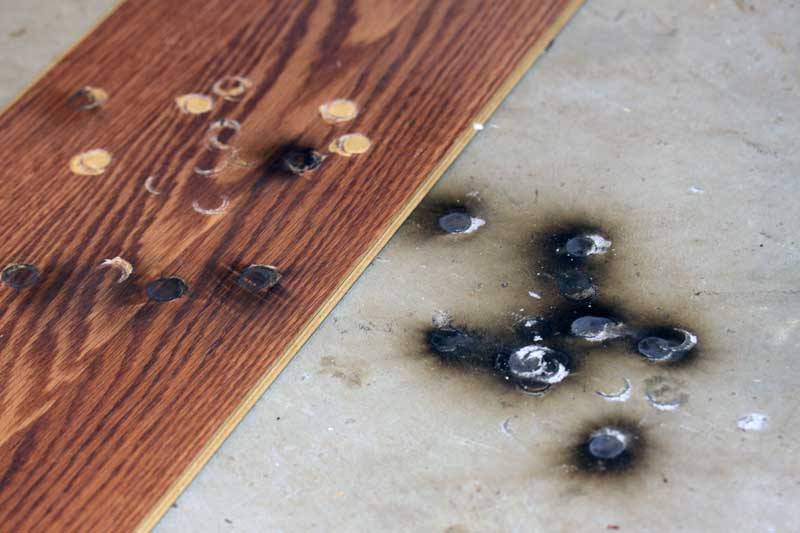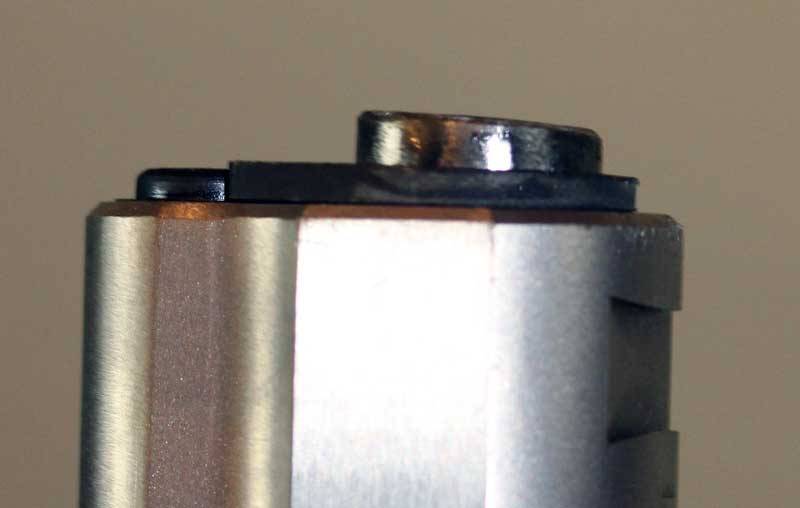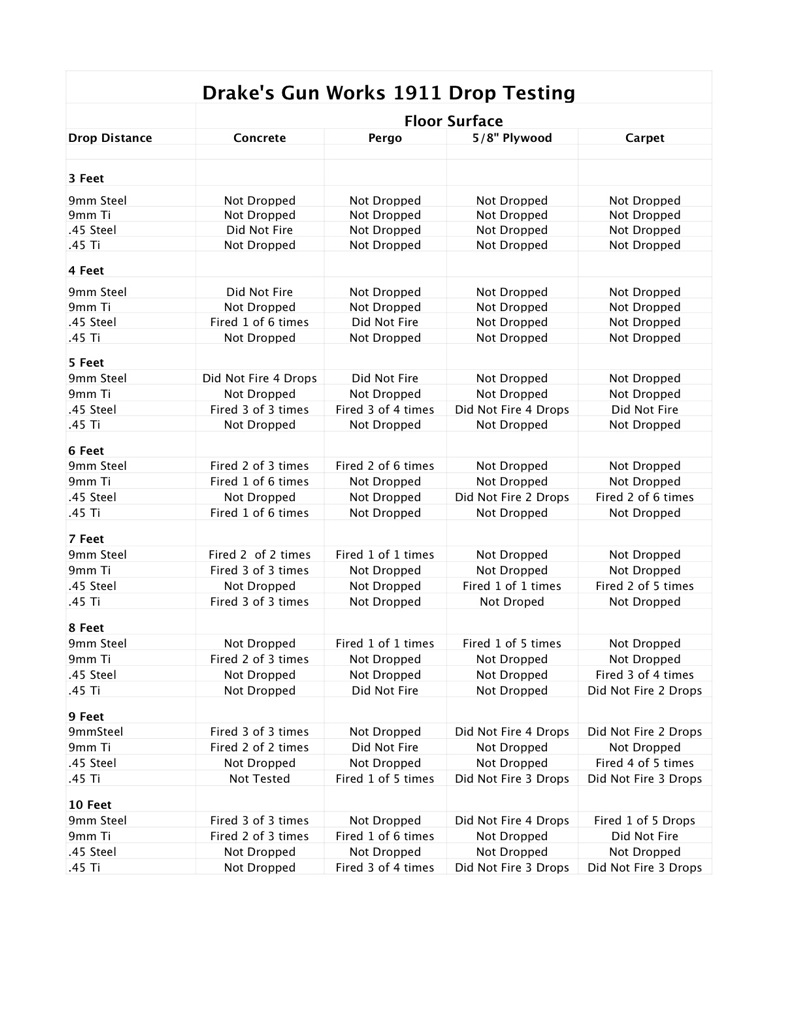
The original testing used a 9mm steel firing pin and a 9mm titanium firing pin. The firing pin hole was then reamed for a .45 sized pin and the tests were repeated with .45 sized steel and titanium firing pins. All of the firing pins were weighed prior to testing. A Wolff XP firing pin return spring was used for all of the testing. All of the cases used for testing used Winchester large pistol primers. The frame and slide were donated by Gary Smith at Caspian. The pistol was built using techniques learned from Larry Vickers and Bruce Gray. The pistol was tied to a section of 550 cord, looped over a pulley, and dropped onto common floor materials. The magazine was loaded with 8 dummy rounds to bring the pistol up to proper weight. Four floor types were selected. Concrete, Pergo, 5/8 plywood, and shag type carpeting. The thumb safety was left OFF as preliminary testing with the safety ON indicated that damage to the thumb safety, slide, and plunger tube would occur with only a few drops. The hammer frequently dropped to the half cock notch during testing.
Firing Pin Weights:
9mm STI titanium pin--- 2.17 grams
9mm Caspian steel pin --- 4.45 grams
.45 STI titanium pin --- 2.36 grams
.45 Colt steel pin --- 4.30 grams
I was amazed at how easily a Series 70 1911 could be drop fired. Steel firing pins and concrete are a bad combination. 9mm sized pins and titanium construction will add several feet to your safe drop distance. I will be running Wolff XP springs and a Ti pin in all of my Series 70 type 1911’s.
I have attached an Excel spread sheet with the results. You will notice a lot of “Did Not Drop” entries. I saw no reason to drop test a particular combination of firing pin and flooring if it was not firing at higher distances or on harder flooring. I did several drops at various distances to get an idea of safe drop distances. This was to account for hard or sensitive primers. Each primed case was dropped only once. Just in case you were wondering, the pistol sustained significant damage. The muzzle is distorted from being dropped. I had to turn down the outside diameter of the barrel three times just to keep the slide from locking up. The muzzle, magwell, and grip safety have some serious blending in their future. Nothing sounds worse than a 1911 hitting the concrete from 10 feet!



Very interesting test! Thanks for doing this, I know how much of a headache this type of testing can be. I reformatted your Excel as a jpg for easier uploading and viewing.

Keep in mind that the manufacturers are aware of the drop fire issues with 1911s, and the path they have historically chosen is that of the firing pin safety. The Colt Series 80 and Swartz variants (S&W, Kimber Series II) are all answers to this, and provide more positive drop safety than a lightened firing pin. That's why we see FP safeties in all modern service pistol designs. The 1911 seems to get by with the lightened firing pins - they pass the CA DOJ and FBI Professional Model contract tests - but I think we generally dislike the FP safeties as 1911 purists. The existing styles of Ti firing pins are about as light as we can go without ending up with light strikes. In a .45, the .45 size Ti pin is very well proven in the Springfield Professional, and Springfield also uses a 9/.38 size Ti pin in all their production guns without any issues.
Drake, great testing. we just had an ND from a 6 ft drop onto concrete with a steel Colt FP in a 70. No injuries, ruined bbl.
Have you ever seen or tested the extra-extra wolff FP spring ? I see he lists it but wonder if it is similiar to the longer FP spring in the Springfields.
I have always wondered if the Swartz design, if dropped high enough would cause the grip safety to move forward enough to move the FP plunger so that the FP could move enough from the drop to fire.
Of course all FP safeties fail at some amount of impact force. If I remember correctly CA DOJ tests the weapons from a height of about waist high or slightly above (40" maybe but I suffer from CRS.)
I used the Wolff extra spring only. I found out in a hurry there were a lot of possible combinations for drops. What I thought would take an afternoon turned into several weeks a few hours at a time. I think the CA DOJ test was from 39". Strangely enough, I just had a decocked P7M13 go off by itself. Broken drop catch safety was holding the firing pin in the retracted position after being decocked. The pin would release randomly. Ned had the same question about a Swartz safety in a Kimber. If you find one you don't want let me know. I'll drop it for you!
I just revisited this, and Drake, great job.
I recently examined a Series 80-style pistol was dropped and discharged. I could not find fault in the system, but I'll bet if we could drop one of these from every angle, the firing pin block would bounce out of the firing pin's path at times. Going by the bang-up marks, this one happened to land such that the extended thumb safety was disengaged..... the beavertail tang also had a mark on it, making me thing that it too might have disengaged momentarily.
I was always suspicious of the Springfields with Ti firing pins and extra, extra-power firing pin springs. I thought they would misfire, but I have not heard anything to support that. You guys with these guns, has any of you fired a thou or two of Wolf? I find Wolf primers a little harder, and if some one has drivin one of these guns through a couple thou of Wolf with no problem, then there almost certainly is no problem.